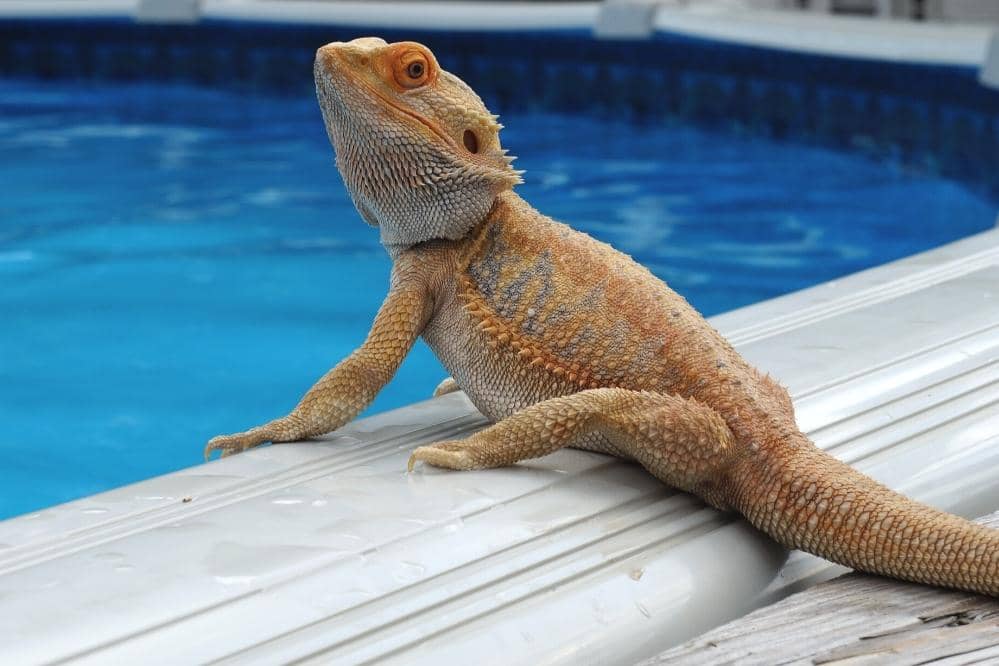Knowing that bearded dragons belong to the hot and dry deserts of Australia, obviously, water is scarce at such places. And that bearded dragons rarely find themselves in a situation where they have to wade through deep water. While giving a bath to a pet bearded dragon, every beardie’s owner observes them moving their limbs and holding their breath, giving the impression as if they are trying to swim. So most beardie owner wonder, “Can bearded dragons swim?” “Do bearded dragons like swimming?” “Is swimming good for bearded dragons?” etc. If you are also looking for the answers to such questions, continue reading.
Can Bearded Dragons Swim?
“YES. ” Despite the fact that bearded dragons don’t come in contact with deep water bodies in the wild, they can swim. Though it’s right that bearded dragons are not very efficient and smooth when it comes to swimming and can’t swim for long, however, if you want a single word answer, it would be “yes.”
How Do Bearded Dragons Swim?
Just like their larger counterparts (the crocodiles and alligators), bearded dragons also use their legs and paws and move their bodies and tails in a specific way to propel the water and navigate around in the water. However, since they are small and can’t swim deep in the water, they have an additional ability to inflate their bodies by inhaling a lot of air. Thus an inflated body helps them float on the water’s surface and keep their head above the water while the rest of the body remains submerged in the water.
Do Bearded Dragons Like To Swim?
As beardie owners, we regularly bathe our bearded friends; however, bathing and swimming are two different types of activities. Since every bearded dragon has a distinct personality, some bearded dragons will enjoy swimming, while others may not like it. So, to assess whether your bearded friend wants to swim or not, you should pay attention to your bearded dragon’s behavior while giving him a bath. If he really enjoys bathing, you should give him an opportunity to swim. Don’t forget to observe your beardie’s behavior closely, and if he shows any sign of stress or fear, don’t force him to swim and immediately take him out of the water.
Should I Allow My Bearded Dragon To Swim / Is Swimming Good for Bearded Dragons?
Yes, if your bearded dragon enjoys swimming, you should definitely give him the opportunity to swim now and then. While thinking about what benefits a bearded dragon gets from swimming, the first answer that comes to mind is exercise. You may wonder if beardies can burn calories by moving around and climbing trees or herbs, especially in the wild, where they have more than enough space. So, why have bearded dragons learned the art of swimming despite evolving from areas where water is scarce, and why do reptile experts advise us to encourage our beardies to swim (if they want to)? The fact is that swimming provides a lot more benefits other than exercise; let’s discuss …….
Swimming: As mentioned earlier, swimming is an excellent exercise for humans and our bearded friends as it involves the whole body
Hydration: In captivity, usually, bearded dragons are not attracted to the water bowl (as many reptile experts say that beardies can’t sense stagnant water). So if beardies in captivity don’t get enough water from their diet, they can quickly become dehydrated. Swimming provides an opportunity for your bearded friend to get rehydrated as they can drink water while swimming. Beardies are also known to uptake water through their vents.
Related Article Do bearded dragons drink water or absorb it?
Skin Health: In addition to drinking and hydration, a bearded dragon can also absorb moisture through their skin. Thus swimming also helps to keep the skin intact and healthy.
Aids In Bowl Movement: One of the significant benefits of swimming is that it can help your beardie to get rid of impaction by stimulating bowel movement. Impaction is a serious (even life threatening issue) that can occur for many reasons. It can be associated with sufficient hydration and exercise, stimulating intestinal movement and relieving constipation or impaction.
Related Article How do I make my bearded dragon poop?
Helps During Shedding: Shedding is a natural but painful process that keeps a bearded dragon uncomfortable for many days. Swimming or bathing in warm water while shedding can soften the skin scalps, thus speeding up their removal, reducing the itchiness and pain, and making them a bit comfortable.
Related Article Should I hold my bearded dragon while shedding?
Enrichment & Mental Stimulation: In addition to physical stimulation, swimming is also an excellent way to keep your bearded dragon mentally stimulated. Naturally, being in the four walls or coming out occasionally and roaming in the same room can be boring or tedious. While swimming provides them with a totally different environment to smell, explore, feel and navigate.
Related Article Do bearded dragons get bored?
How Often & How Long Should I Allow My Bearded Dragon to Swim?
If you have a bearded dragon that likes to be in the water and enjoys swimming, don’t get too excited and remember that it’s enough if you allow him to swim for 15-20 minutes once a week. Anything more than that can harm your beardie because they are not aquatic animals, after all, and can’t spend too much time in the water.
Things To Consider, To Keep Bearded Dragons Safe While Swimming
1. Know Your Beardie (Temperament & Personality)
Before putting your bearded dragon in water, the first and most crucial thing is to know your beardie’s personality and temperament. Not all bearded dragons necessarily like swimming. So if your bearded friend doesn’t like swimming, never force him.
2. Water Temperature
Due to their ectothermic nature, the environmental temperature is crucial for bearded dragons, whether in the tank, roaming in the room, or swimming in water. So make sure the water temperature is between 90 0F and 100 0F. Swimming in cold water will adversely affect the health of your beardie.
3. Water Depth
Since bearded dragons are not efficient swimmers, they can’t swim in deep water. So while filling the pool or tub for your beardie ensures that the water level should not be higher than the shoulder joint. Deeper water (above shoulder height) poses a greater risk of drowning to the bearded dragon.
4. Supervise Your Beardie At All Times
It doesn’t matter how good your bearded dragon at swimming is or how much he likes to be in water; don’t leave him unsupervised at any time. He may need your help at any moment, and leaving him alone can cost you the life of your bearded friend.
5. Warm Your Bearded Dragon After Swimming
Once the swimming time is over, gently pick your beardie out of the water, wrap it in a soft cloth (preferably a towel) and pet him dry. Avoid rubbing the beardie’s body, especially during shedding. After drying, place him back in its enclosure under the basking lamp.

